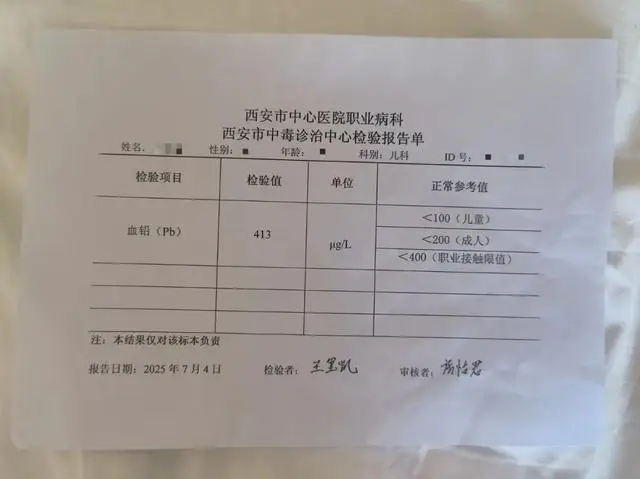
On July 12, Gansu Province established a provincial party committee and government investigation team to upgrade the investigation of abnormal blood lead levels of children in Brownstone Peixin Kindergarten in Maiji District, Tianshui City (hereinafter referred to as “Brownstone Peixin Kindergarten”), and invited experts from the Ministry of Ecology and Environment, the National Health Commission and other ministries and commissions to participate. The State Council Food Safety Office sent a working group to guide and supervise.
Many parents told China News Weekly that some of the first batch of children hospitalized in Xi’an Central Hospital have been discharged. After receiving 3 days of lead removal treatment and 4 days of trace element supplementation, the children with abnormal blood lead levels underwent venous blood draw re-examination. Some children whose blood lead concentrations were lower than 250 micrograms/liter in the re-examination have been discharged from the hospital since July 11. After discharge, these children will continue to supplement other trace elements to assist in lead removal, and are expected to return to Xi’an Central Hospital for re-examination in four to six weeks.
Geng Wei (pseudonym)’s child had blood lead concentrations of 413 micrograms/liter and 305 micrograms/liter in two tests at Xi’an Central Hospital on July 4 and July 11, respectively. Photo/provided by the interviewee.
The child of parent Geng Wei was admitted to Xi’an Central Hospital for treatment on July 4, with a blood lead concentration of 413 micrograms/liter when he was admitted. When he was re-examined on July 11, it dropped to 305 micrograms/liter. To avoid the side effects of lead removal, the doctor recommended that the child continue to use lead removal drugs for three days, and he is expected to be discharged around July 15.
The children of Brownstone Peixin Kindergarten are placed in different areas of Xi’an Central Hospital, such as the pediatrics and inpatient departments. Geng Wei’s child lives in the inpatient department. Through visits on different floors and WeChat communication, he found that the blood lead concentration of many children treated in Xi’an Central Hospital has dropped by 100-150 micrograms/liter. “There are about 30 children on my child’s floor, and half of them have been discharged. The blood lead concentration of the children who are still hospitalized is mostly over 300 micrograms/liter when they are admitted.” He said.
For parents, they hope that this upgraded investigation can answer questions that were omitted in the previous report. According to the notice issued by the local joint investigation team on July 8, the source of the lead was the paint purchased by the kitchen staff of the kindergarten through the online platform. The paint was diluted and used in the production of some foods, and the packaging clearly indicated that it was not edible. Parents believe that the previous notice did not explain how long the children had eaten lead-containing foods, why they were illegally added, and why there was a large difference in the test results between Tianshui and Xi’an.
Many parents said that many doubts discussed online have been gradually eliminated. Although there is a lead mine near the kindergarten, the blood lead concentration of the children’s parents and their brothers and sisters, as well as the children in the other three kindergartens under the name of the controller of the kindergarten, did not exceed the standard. Moreover, among the children with lead poisoning this time, the longer they entered the kindergarten, the higher their blood lead concentration was generally; among the children with normal blood lead levels, some had just entered the kindergarten for a few days, and some only ate breakfast in the kindergarten. Some children who graduated in July 2024 were also found to have blood lead concentrations between 50 and 100 micrograms/liter.
The notice issued by the local joint investigation team showed that after testing 223 samples of food samples, the three-color red date steamed cakes for breakfast and corn roll sausages for dinner at Brownstone Peixin Kindergarten failed the test. The lead content of the two samples was 1052 mg/kg and 1340 mg/kg, respectively, both exceeding the 0.5 mg/kg limit of food contaminants in the national food safety standard.
Parent Meng Jing told China News Weekly that judging from the current distribution of excessive blood lead, she and many parents believe that the food provided by the kindergarten is very likely to be the main source of lead poisoning. Photos saved in the parent group show that these two foods have appeared on the kindergarten menu as early as August 2024. The kindergarten prepares colorful meals every week, and the teachers take photos and send them to the group.
An unnamed child lead poisoning prevention and control expert previously told China News Weekly that the lead absorption rate of children aged 3 to 6 is about 30% to 50%. According to the lead content of the food samples collected in the notice, it is estimated that young children only need to consume a very small amount of such food to cause excessive blood lead levels, and the symptoms of young children meet the standards of chronic lead poisoning.
Some analysts believe that the paint pigments found to be lead sources may contain lead chromate. The lead in lead chromate is neurotoxic, and the hexavalent chromium in it is a Class I carcinogen with strong oxidizing and cell penetrating properties.
A professor from the School of Public Health of a “double first-class” university who did not want to be named told China News Weekly that the chromium content in lead chromate is relatively low, which mainly poses a hazard to the digestive system. The absorption rate of hexavalent chromium is not high, and the proportion of hexavalent chromium entering the blood through the digestive tract is not large. Therefore, to evaluate the hazards of hexavalent chromium, it is necessary to refer to the concentration of chromium in the blood.
The inspection report issued by Xi’an Central Hospital did not include chromium testing. However, early reports provided by many parents showed that before July, the laboratory reports of Tianshui Integrated Traditional Chinese and Western Medicine Hospital and Xi’an Children’s Hospital showed that the blood chromium concentration of many children was between 0.1 and 0.2 micrograms/liter, which was within the reference range (less than 5 micrograms/liter). Geng Wei introduced that at present, Xi’an Central Hospital has informed parents that it is temporarily unable to provide chromium testing services. Some children who have been discharged from the hospital went to other hospitals for self-testing accompanied by their parents, but the test results have not yet been obtained.
Brownstone Peixin Kindergarten holds an open day every semester and invites parents to visit. Meng Jing visited the kindergarten kitchen in April this year, and she saw the kitchen was labeled with additives. The director explained at the time that the kitchen only used two additives: baking soda and yeast. Meng Jing introduced that in addition to the open day visit, the photos of the kitchen food shown to parents by the kindergarten did not show painted pigments. She believed that the kindergarten deliberately concealed the painted pigments, and she was more puzzled as to why the local authorities did not find painted pigments during their daily inspections of the kindergarten kitchen.
Many parents said that they are now more worried about the irreversible long-term effects of lead poisoning on children’s health. The professor who did not want to be named has been studying the problem of lead poisoning in children for a long time. He said that if the blood lead concentration of young children can return to normal within one to two months, the harm is relatively controllable. Part of the lead will circulate in the blood and be deposited in the bones in the form of water-insoluble lead phosphate, which is relatively stable. However, with the acceleration of metabolism, or in the case of osteoporosis, lead phosphate may be converted into lead hydrogen phosphate and gradually released into the blood. He suggested that children should have regular blood lead tests after the blood lead level drops below 100 micrograms/liter.
“Low-dose, long-term blood lead abnormalities should be more vigilant.” The expert said that from a toxicological point of view, there is no absolute safety value for lead, and any level of lead exposure may affect health. At present, China sets the standard for high leademia at 100 micrograms/liter, which is only a relatively acceptable reference value. If blood lead remains near this level for a long time, it should also be taken seriously and the source of lead in life should be identified as soon as possible. “At present, lead is still widely present in our daily life and industrial environment. The abnormal blood lead level caused by it is an environmental problem that needs to be taken seriously,” he said.






